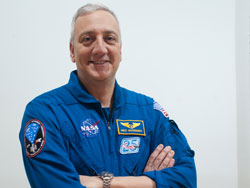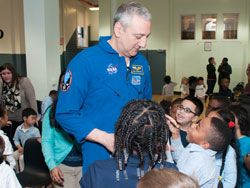Filed Under > NYC Schools
Reach for the Stars, TCCS Students Are Told by a Guy Who's Come Close
An astronaut reveals the secret to his success and why no one likes freeze-dried ice cream
Mike Massimino was six years old when he watched the live coverage of Neil Armstrong walking on the moon. He decided right then to become an astronaut, but his journey to space took years of hard mental and physical preparation, with some wrenching setbacks along the way.
“If there’s something you want to do, you’ve got to stick with it and keep trying,” Massimino told students at Teachers College Community School when he stopped by for a chat on Jan. 24.
Getting an astronaut to come to your school requires a few connections, and TCCS definitely has them. Massimino is currently on loan from NASA teaching at Columbia University’s Fu Foundation School of Engineering and Applied Science, where he earned his bachelor’s degree. He was invited to TCCS by parents Christine Kovich and Sam Sia, co-founders of Harlem BioSpace, a biotech incubator near the school. Sia is also a Columbia faculty member in biomedical engineering, and Kovich started the BioSpace project HYPOTHEkids, a nonprofit that teaches science at TCCS and runs the school’s science after-school program.
TCCS, located in Harlem on Morningside Avenue near 126th Street, is a non-selective, public neighborhood school that provides an excellent education based on the most up-to-date educational research available through its affiliation with Teachers College. Comprehensive educational services, such as psychological evaluations and counseling and after-school science classes, are provided by Columbia University.
Massimino told the packed room of students, teachers and parents about the tough challenges he faced along his own career path. After graduating from Columbia, Massimino earned master’s and doctorate degrees in mechanical engineering at MIT, worked in private business and won two patents, and did a lot of extra studying and strenuous physical conditioning to prepare for his NASA tryout. He was rejected three times before being selected on his fourth try as an astronaut candidate in 1996.
That was only the beginning of years of additional preparation for two space missions – the second of which, to service the Hubble Space Telescope in 2009, included a spacewalk that loosely inspired the recent film Gravity. Wearing a 200-pound space suit with protective helmet and thick gloves and floating weightlessly in pitch-black outer space, Massimino had trouble removing a handrail from the Telescope in order to repair a piece of equipment. The first tool he used didn’t work, then a second one failed, until finally, he yanked the handrail off and proceeded with the repair.
In the Q&A session following his talk, Massimino emphasized that being an astronaut was difficult but fun.
One by one, children ages five through seven – two wearing astronaut uniforms – filed up to the front of the room to ask questions that reflected their enchantment, excitement and a little awe.
How fast does the space ship go?
“You go very, very fast in the space ship – really, really fast. You go from zero to 17,000 miles per hour. You need all that speed to get up into space.”
What was your favorite space food and your least favorite space food?
“Favorite – ravioli. Least favorite – ice cream, because it’s not really ice cream.”
What does the earth look like from the shuttle?
“It’s the most beautiful thing I have ever seen.”
What’s the future of space exploration?
“Tourists and private companies – not just NASA – want to go to space now. I would hope that when you’re old enough to be an astronaut, there will be lots of opportunities.”
Do you think humans will live on another planet?
“Yes, I do. I think humans might someday live on the Moon or Mars, or another planet.”
How many stars are there?
“Billions.”
How has being an astronaut changed your life?
“It’s taught me that you may have to work a lot and stick with it, but dreams do come true.”
Published Tuesday, Jan. 28, 2014

